Clinical observation on regulating Conception Vessel and unblocking Governor Vessel by acupuncture combined with tuina for cerebral infarction
2015-05-18YanBing闫兵LiuYongfeng刘永锋ZengXuexia曾雪霞
Yan Bing (闫兵), Liu Yong-feng (刘永锋), Zeng Xue-xia (曾雪霞)
Department of Acupuncture and Moxibustion, Shenzhen Hospital of Traditional Chinese Medicine, Guangdong 518000, China
Clinical Study
Clinical observation on regulating Conception Vessel and unblocking Governor Vessel by acupuncture combined with tuina for cerebral infarction
Yan Bing (闫兵), Liu Yong-feng (刘永锋), Zeng Xue-xia (曾雪霞)
Department of Acupuncture and Moxibustion, Shenzhen Hospital of Traditional Chinese Medicine, Guangdong 518000, China
Objective:To observe the clinical effect of regulating Conception Vessel and unblocking Governor Vessel by acupuncture combined with tuina for cerebral infarction.
Acupuncture-moxibustion Therapy; Electroacupuncture; Scalp Stimulation Areas; Tuina; Massage; Poststroke
Known as wind stroke in Chinese medicine, cerebral infarction commonly affects the middle-aged and elderly people. At present, there are 7.5 to 8 million stroke patients in China[1]. Cerebrovascular disease has been listed as critical illness in the National Mediumand Long-term Program for Science and Technology Development Outline (2006-2020) and the Eleventh Five-year Plan for Traditional Chinese Medicine Development. Therefore, an active prevention system against cerebral infarction is beneficial to national welfare and people’s livelihood. In addition, it also benefits medical care and eases the burden of medical resources[2]. Acupuncture has always been an important method for cerebral infarction in China[3-4]. Over the recent years, it has also attracted attention worldwide because of its convenience and remarkable effect. We’ve treated cerebral infarction with regulating Conception Vessel and unblocking Governor Vessel by acupuncture combined with tuina. The results are summarized as follows.
1 Clinical Data
1.1 Diagnostic criteria
This was based on diagnostic criteria stipulated in the 4th National Academic Conference for Cerebrovascular Disease in 1995[5].
1.1.1 Atherosclerotic thrombotic cerebral infarction
Quiet rest onset; absence of noticeable headache and vomiting; insidious onset with slow or stage progression, often associated with cerebral atherosclerosis and can also be seen in arteritis or blood diseases; generally a clear consciousness within 1-2 d of onset or progress obstacles; presence of signs and symptoms of internal carotid and/or vertebrobasilar artery systems; and CT scan and MRI examination confirmed absence of red blood cells in cerebrospinal fluid by lumbar puncture.
1.1.2 Lacunar infarction
Acute or sub-acute lacunar stroke onset often induced by hypertensive arteriosclerosis; a clear consciousness; confirmed by CT scan or MRI examination; mild signs and symptoms, commonly manifesting as pure sensory stroke, pure motor stroke/ hemiparesis, ataxic hemiparesis, dysarthria/clumsy hand or mixed sensorimotor stroke; and absence of red blood cells in cerebrospinal fluid by lumbar puncture.
1.2 Inclusion criteria
Those who met the diagnostic criteria of cerebral infarction; aged between 40 and 80 years without gender limitation; confirmed by CT scan or MRI examination; and signed the informed consent.
1.3 Exclusion criteria
Cerebral hemorrhage and transient cerebral ischemia need to be ruled out.
1.4 Statistical methods
The SPSS 12.0 version software was used for statistical analysis. Thet-test was used for measurement data, which was expressed in the form of. The Chi-square test was used for comparison of effective rate.P<0.05 indicates a statistical significance.
1.5 General material
A total of 61 inpatients between March 2013 and October 2014 were recruited in this study. There were 40 males and 21 females, aged between 42 and 76 years. Their disease duration lasted between 3 weeks and 2 years. There were 10 severe infarction cases, 36 moderate infarction cases and 15 mild infarction cases.
2 Treatment Methods
2.1 Acupuncture therapy
Major points: Baihui (GV 20), Shenting (GV 24), Shuigou (GV 26), Lianquan (CV 23), Guanyuan (CV 4), Qihai (CV 6) and Zhongji (CV 3).
Adjunct points: Three temporal points (one point is located 2 cun directly above the tip of the ear, and the other two points are located 1 cun anterior and posterior respectively), three hand points [Quch (LI 11), Hegu (LI 4) and Waiguan (TE 5)], Neiguan (PC 6), three foot points [Zusanli (ST 36), Sanyinjiao (SP 6) and Taichong (LR 3)], Huantiao (GB 30), Weizhong (BL 40), Yanglingquan (GB 34) and Kunlun (BL 60).
Points based on pattern identification: Combine with Taixi (KI 3) and Fengchi (GB 20) for hyperactivity of liver yang; combine with Fenglong (ST 40) and Fengchi (GB 20) for wind phlegm obstructing the meridians; combine with Quchi (LI 11), Neiting (ST 44) and Fenglong (ST 40) for phlegm heat in the stomach and large intestine; and combine with Xuehai (SP 10) and Danzhong (CV 17) for qi deficiency and blood stasis.
Method: All major points were punctured for each treatment, coupled with necessary adjunct points. Disposable filiform needles of 0.38 mm in diameter and 25 mm in length were used in this study. After routine sterilization, Shuigou (GV 26) was punctured 0.1-0.3 cun obliquely towards upward, followed by 10-15 s of heavy reducing manipulation by twirling. Baihui (GV 20) and Shenting (GV 24) were punctured 0.3-0.5 cun subcutaneously and connected with G6805-2 electric stimulator upon arrival of qi, using a sparse-dense wave at the frequency of 2 Hz/15 Hz and an intensity of 20 mA for 30 min. The rest points were punctured with normal method and followed by reinforcing manipulation for deficiency syndrome and reducing manipulation for excess syndrome. During needle retaining, a moxa box (20 cm × 15 cm × 10 cm) containing 6 moxa cones was placed on Guanyuan (CV 4), Qihai (CV 6) and Zhongji (CV 3). The treatment was done once a day for 12 d (a course). There was a 3-day interval between two courses. The patients were treated for 3 courses.
2.2 Tuina therapy
Points on the head and face: Contralateral Motor and Language Areas of hemiplegia, Jiache (ST 6), Dicang (ST 4), Yamen (GV 15) and Fengchi (GB 20).
Points on the affected upper and lower limbs: Jianjing (GB 20), Jianyu (LI 15), Quchi (LI 11), Shousanli (LI 10), Hegu (LI 4), Waiguan (TE 5), Huantiao (GB 30), Fengshi (GB 31), Weizhong (BL 40), Yanglingquan (GB 34), Zusanli (ST 36), and Kunlun (BL 60).
Points on the back and low back: Dazhui (GV 14), Feishu (BL 13), Pishu (BL 20), Geshu (BL 17) and Shenshu (BL 23)[6].
Main manipulations: Gun-rolling, An-pressing, Diandigital pressing, Na-grasping, Mo-rubbing and Yaoshaking.
Treatment procedure for the affected upper limb: First, applied 3-5 min of Mo-rubbing to the Motor and Language Areas on the scalp (Figure 1); then, applied 3-5 min of Gun-rolling and Na-grasping to both sides of the affected upper limb (Figure 2); next, applied Dian-digital pressing to Jianjing (GB 20), Quchi (LI 11), Shousanli (LI 10), Neiguan (PC 6) and Hegu (LI 4), 3 minfor each point (Figure 3); and finally, applied Niantwisting and Yao-shaking to the fingers, shoulder, elbow and wrist joints (Figure 4 and Figure 5).
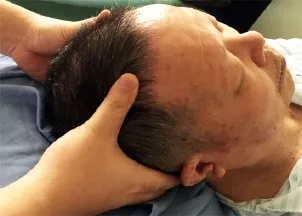
Figure 1. Mo-rubbing the Motor and Language Areas
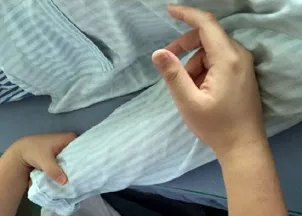
Figure 2. Gun-rolling the affected upper limb

Figure 3. Dian-digital pressing Hegu (LI 4)
Treatment procedure for the affected lower limb: First, applied 10-15 min of Gun-rolling and Na-grasping to both sides of the lower limb (Figure 6); then, applied An-pressing to Futu (ST 32), Xuehai (SP 10), Fengshi (GB 31), Zusanli (ST 36) and Yongquan (KI 1), 3 min for each point (Figure 7); next, applied 20-30 times of Kou-tapping to the heel (Figure 8); and finally, applied Yao-shaking to the hip, knee and ankle joints coupled with 5-10 times of flexion and extension of the lower limb (Figure 9).
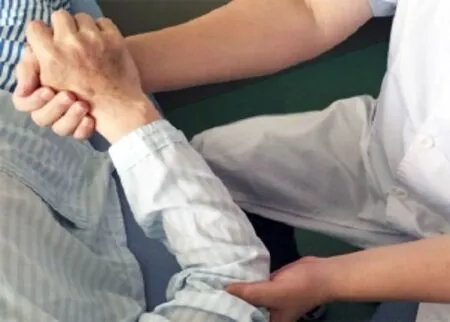
Figure 4. Yao-shaking the elbow joint
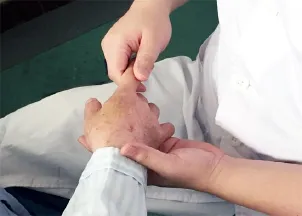
Figure 5. Nian-twisting the knuckles
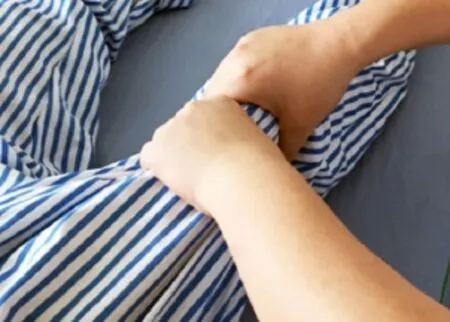
Figure 6. Na-grasping the lower limb

Figure 7. Dian-digital pressing the points on the lower limb
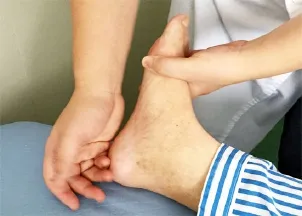
Figure 8. Kou-tapping the heel
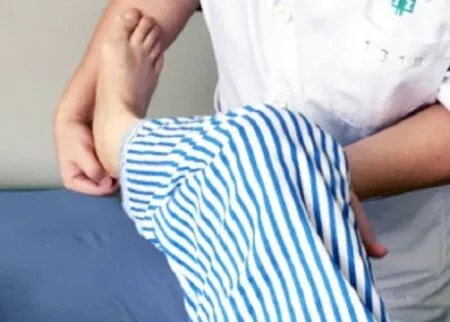
Figure 9. Yao-shaking the lower limb coupled with flexion and extension
3 Therapeutic Efficacy Observation
3.1 Observation items
3.1.1 Neurological deficit severity grading
The neurological deficit severity was assessed before and after treatment[7]. The patients’ consciousness, horizontal gaze, presence and severity of facial palsy, speech function, muscle strength of the upper and lower limbs and walking ability were scored, and a higher score represents a more severe neurological deficit.
3.1.2 Patients’ residual disability rating scale
This was based on the therapeutic efficacy evaluation criteria stipulated in the 4th National Academic Conference for Cerebrovascular Disease in 1995 organized by Chinese Medical Association. The residual disability rating was assessed according to patients’consciousness, language and motor function before and after treatment.
Grade 0: Return to work or able to manage housework.
Grade 1: Capable of self-care, independent life and able to manage some work.
Grade 2: Almost live independently and need minor help.
Grade 3: Able to manage some daily living activities and need major help.
Grade 4: Able to stand and walk but depend on help.
Grade 5: Confined to bed, able to sit but need extensive help.
Grade 6: Confined to bed, occasionally conscious and need to be fed by others.
Grade 7: A vegetable state.
3.2 Clinical efficacy criteria
Almost full recovery: Neurological deficit score decreased by 90%-100% and grade 0 of residual disability.
Marked progress: Neurological deficit score decreased by 46%-89% and grade 3 of residual disability.
Progress: Neurological deficit score decreased and grade 1-3 of residual disability.
No change: Neurological deficit score decreased by 18%-45%.
Deteriorated: Neurological deficit score increased by less than 18%.
3.3 Therapeutic efficacy criteria for symptoms of traditional Chinese medicine (TCM)
This was based on the efficacy evaluation criteria for stroke stimulated in theGuiding Principles for Clinical Study of New Chinese Medicines[8]. The decrease rate of symptom scores (DRSS) was calculated using Nimodipine method.
DRSS = (Pre-treatment score - Post-treatment score) ÷ Pre-treatment score × 100%.
Clinical recovery: Absence or almost absence of TCM signs and symptoms, coupled with DRSS ≥95%.
Marked effect: Alleviated TCM signs and symptoms, coupled with DRSS ≥70% but <95%.
Improvement: Improved TCM signs and symptoms, coupled with DRSS ≥30% but <70%.
Failure: TCM signs and symptoms remain unchanged, coupled with DRSS <30%.
3.4 Results
All cases in this study showed a good compliance and there were no dropouts.
3.4.1 Changes in neurological deficit scores before and after treatment
Before treatment, the neurological deficit score was (18.65±3.28) points. This score gradually decreased over the three treatment courses. The neurological deficient score was (13.63±3.91) points, (9.53±3.22) points and (5.57±3.97) points respectively after 1, 2 and 3 courses. showing a statistical significant difference in comparison with that before treatment (P<0.05). This indicates that patients’ neurological functions increased with the treatment courses.
3.4.2 Therapeutic efficacy comparison in patients with different severities
After three treatment courses, the total effective rate was 90.2%. The Ridit analysis showed Rsevere=0.05, Rmoderate=0.05 and Rmild=0.05. Analysis of variance showed Z=1.253, indicating a significant inter-group difference. The between-group comparison for least significant difference (LSD) showed tsevere-moderate=0.02, P<0.05; tsevere-mild=0.02, P<0.05; and tmoderate-mild=0.02, P<0.05. This indicates that patients with mild conditions can obtain better effects than those with severe conditions (Table 1).

Table 1. Correlation between disease severity and therapeutic efficacy (case)
4 Discussion
According to official statistics in 2005, the stroke mortality in China was the second in the world[9]. Approximately 43.7%-78.9%[10-11]of stroke patients experienced cerebral infarction. In TCM, cerebral infarction falls under the category of wind stroke. Factors contributing to wind stroke are wind, fire, phlegm, deficiency and stasis. Modern studies have proven that acupuncture plays a significant role in prevention and treatment of ischemic stroke[12]. Because of its convenience and reliable efficacy, acupuncture has been considered an important method for hemiplegia due to cerebral infarction. The World Health Organization (WHO) also listed cerebral infarction as one of the acupuncture indications.
Since cerebral infarction results from malnourishment of the body due to deficiency of Yuan-primordial qi and phlegm-stasis obstructing the meridians, the primary treatment principle is to unblock meridians. As the sea of yang meridians, the Governor Vessel connects yin with yang. It originates from the lower abdomen, comes out of the perineum, travels along the spine to the back of the neck and enters the brain. One of its branches connects with the kidney and spreads over the heart. Both the Governor Vessel and Conception Vessel originate from the lower abdomen. Therefore, through the Conception Vessel, it also connects with all yin meridians. Since the Governor Vessel is often impaired in the event of stroke, this study employed needling points of the Conception and Governor vessels combined with tuina to regulate and unblock meridian qi. Of selected points, Baihui (GV 20) can lift yang qi of the body, Shenting (GV 24) can regulate the mind, and Shuigou (GV 26) can awaken the brain. Modern medical science has also confirmed that needling points of the Governor Vessel can mitigate brain function injury due to cerebral ischemia and enhance brain function recovery during reperfusion. In addition, needling points of the Governor Vessel in the head can regulate the contents of vasoactive substances in brain tissue, dilate brain blood vessels, increase cerebral blood flow and thus protect brain neurons due to cerebral ischemia[13-14]. Studies have suggested that needling points of the Governor Vessel can significantly reduce the blood viscosity, packed cell volume and red cell assembling index, increase blood supply to the brain and benefit the recovery of cerebral nerve function. This might explain the action mechanism of needling points of the Governor Vessel for stroke[15].
In light of essential TCM theories such as ‘the Governor Vessel is the sea of yang meridians’, ‘the Conception vessel is the sea of yin meridians’, ‘yin and yang are mutually rooted’ and ‘balance between yin and yang’, we can assume that in addition to the Governor Vessel, the Conception Vessel may also play a significant role in helping with repair of ischemic brain injury. The Governor Vessel conducts motor information, whereas the Conception Vessel conducts sensory information. The Governor Vessel that comes out of Fengfu (GV 16) travels with the downward insertion and termination of corticospinal tract, whereas the Conception Vessel travels with the insertion and termination of upwardspinothalamic tract, slender fasciculus and cuneate fasciculus. Since the back is ascribed to yang and abdomen is ascribed to yin, the Governor Vessel is the projection of corticospinal tract on the posterior midline, whereas the Conception Vessel is the projection of spinothalamic tract, slender fasciculus and cuneate fasciculus on the anterior midline.
The Conception Vessel winds around the lips and separates into two branches to enter the eyes and then terminates at the thalamus. This is consistent with the modern medical theory about the function of thalamus in relaying sensory signals to the cerebral cortex. Apparently, the Conception Vessel is associated with the spinothalamic tract, slender fasciculus, cuneate fasciculus and sensory thalamic fasciculus in the head and face. As a result, the Governor and Conception Vessels are both involved in protection of the brain function. Because they are directly or indirectly associated with the brain in their pathways, physiological functions and pathological changes, these two vessels, of all twelve regular and eight extraordinary meridians, have the closest relationship with the brain. That’s why we proposed this special acupuncture therapy for stroke. The Conception Vessel travels along the front midline and governs all yin meridians. As Lianquan (CV 23), Guanyuan (CV 4), Qihai (CV 6) and Zhongji (CV 3) are crossing points between the Conception Vessel and Three Yin Meridians of Foot, needling them can regulate functions of yin meridians.
Tuina therapy was also combined in this study, since tuina can circulate qi, relax tendons and regulate qi and blood. Tuina manipulation on the head and face can help to resolve hematoma dissolve thrombosis, recover brain function and alleviate unnecessary necrosis[16]. In addition, tuina can regulate excitation and inhibition of central nervous system, increase blood circulation and metabolism and prevent muscular atrophy[17]. What’s more, early application of tuina can connect central nervous circuity and promote limb movement or muscle contraction.
Results in this study have shown that the patients’neurological deficit scores were significantly decreased after three treatment courses and those with a mild condition obtained better effects. This indicates that acupuncture method in this study combined with tuina can effectively improve the hemiplegic limb function in patients with cerebral infarction.
Conflict of Interest
There was no conflict of interest in this article.
Statement of Informed Consent
Informed consent was obtained from all individual participants included in this study.
Received: 30 November 2014/Accepted: 5 January 2015
[1] Cai DS. Fast growing market of protective agents for cerebral circulation and metabolism. Jingji Yu Shichang, 2009, 3(10): 18-25.
[2] Yang F, Huang JR, Mao SS. Analysis on current situation on TCM clinical research. Zhongyiyao Guanli Zazhi, 2011, 19(11): 1012-1014.
[3] Yao WJ, Ouyang BS. Effect of relaxing needling plus rehabilitation training on post-stroke upper limb dysfunction. J Acupunct Tuina Sci, 2014, 12(3): 146-149.
[4] Liu J, Bao CL, Zhang GB, Jiao ZH, Dong GR. Clinical observations on yin-yang-balancing point-to-point acupuncture for walking function reconstruction in patients with post-stroke spastic paralysis. Shanghai Zhenjiu Zazhi, 2014, 33(1): 7-10.
[5] Chinese Neuroscience Society, Chinese Neurosurgical Society. Key diagnostic points for cerebrovascular diseases. Zhonghua Shenjingke Zazhi, 1996, 29(6): 379-380.
[6] Shi XM. Science of Acupuncture and Moxibustion. Beijing: China Press of Traditional Chinese Medicine, 2007.
[7] Chinese Society of Psychiatry. Clinical neurologic deficient severity scoring standard in stroke patients. Zhonghua Shenjingke Zazhi, 1996, 29(6): 381-383.
[8] Ministry of Health of the People’s Republic of China. Guiding Principles for Clinical Study of New Chinese Medicines. Beijing: China Medico-Pharmaceutical Science & Technology Publishing House, 2002: 349-353.
[9] Ministry of Health of the People’s Republic of China. 2006 Year Book of Health. Beijing: Peking Union Medical College Press, 2006: 45.
[10] Jiang B, Wang WZ, Chen HL, Hong Z, Yang QD, Wu SP, Du XL, Bao QJ. Incidence and trends of stroke and its subtypes in China: result from three large cities. Stroke, 2006, 37(1): 63-68.
[11] Zhang LF, Yang J, Hong Z, Yuan GG, Zhou BF, Zhao LC, Huang YN, Chen J, Wu YF. Proportion of different subtypes of stroke in China. Stroke, 2003, 34(8): 2091-2096.
[12] Zhao Y. Advance in clinical research on acupuncture for cerebral infarction. Jiangxi Zhongyiyao, 2009, 40 (4): 77-78.
[13] Ying SX, Cheng JS. Effect of electroacupuncture on brain electrical activity in gerbils with cerebral ischemia and reperfusion. Zhen Ci Yan Jiu, 1994, 19(2): 29.
[14] Xu NG, Xu GS, Zhong P, Wang LF, Zhu SL, Chen QZ. Effect of electroacupuncture at Governor Vessel points on nitric oxide and endothelin in rats with acute cerebral ischemia. Zhen Ci Yan Jiu, 1996, 21(3): 18.
[15] Li BL. Clinical research on treatment of apoplectic hemiplegia by acupuncture of Du Meridian as main therapy. Shanghai Zhenjiu Zazhi, 2002, 21(1): 13-14.
[16] Nie PK, Zhao XF, Wang S. Research advance in tuina for stroke. Jiangsu Zhongyiyao, 2008, 40(5): 91-92.
[17] Lu JH. Rehabilitative nursing for 58 stroke cases. Jinggangshan Yizhuan Xuebao, 2001, 8(2): 89.
Translator:Han Chou-ping (韩丑萍)
调任通督针灸配合推拿治疗脑梗死临床观察
目的:观察调任通督针法配合推拿治疗脑梗死的临床疗效。方法:对符合纳入标准的61例脑梗死患者,予以调任通督针法配合推拿治疗, 每日1次, 12次为1疗程, 疗程间休息3天, 共治疗3个疗程。治疗前通过神经功能缺损评分进行病情轻重分级。治疗 1、2、3个疗程后分别进行神经功能缺损评分及病情轻重与疗效关系的评定。结果:治疗前, 患者神经功能缺损评分为(18.65±3.28)分,治疗1、2、3个疗程后评分分别为(13.63±3.91)分、(9.53±3.22)分和(5.57±3.97)分。经过3个疗程的治疗, 61例患者中基本痊愈4例, 显效33例, 有效18例, 无效6例, 总有效率90.2%。结论:调任通督针灸结合推拿治疗能有效改善脑梗死偏瘫肢体功能。
针灸疗法; 电针; 头针刺激区; 推拿; 按摩; 中风后遗症; 脑梗死
R246.6 【
】A
Author: Yan Bing, master degree candidate, attending physician.
E-mail: 99566405@qq.com
Methods:A total of 61 eligible cases with cerebral infarction were treated with regulating Conception Vessel and unblocking Governor Vessel by acupuncture combined with tuina, once a day, 12 d for a course. There was a 3-day interval between two courses. These cases were treated for 3 courses. Before treatment, the infarction severity was graded using neurological deficit score. The score changes and correlation between infarction severity and therapeutic efficacy were evaluated after 1, 2 and 3 courses of treatment.
Results:Before treatment, the neurological deficit score was (18.65±3.28), versus (13.63±3.91), (9.53±3.22) and (5.57±3.97) respectively after 1, 2 and 3 courses of treatment. When the third course was completed, 4 cases obtained almost full recovery, 33 cases obtained marked effect, 18 cases obtained improvement and 6 cases had no effect. The total effective rate was 90.2%.
Conclusion:Regulating Conception Vessel and unblocking Governor Vessel by acupuncture combined with tuina can substantially improve limb function in patients with hemiplegia due to cerebral infarction.
Syndrome; Cerebral Infarction
猜你喜欢
杂志排行
Journal of Acupuncture and Tuina Science的其它文章
- Anti-depression effects of electroacupuncture through up-regulating serum E2and BDNF and expression of BDNF in hippocampus in chronic depression rats
- Effects of wrist-ankle acupuncture on associated factors in uterus tissue and serum in rats with primary dysmenorrhea
- Clinical study on acupuncture combined with low-frequency electric stimulation for scissor gait in children with spastic cerebral palsy
- Observation on therapeutic effect of half puncture plus transcutaneous acupoint electric stimulation for infantile facial paralysis
- Tuina combined with needling distal points for pseudo-myopia in adolescents
- Therapeutic efficacy observation on electroacupuncture for Alzheimer’s disease
